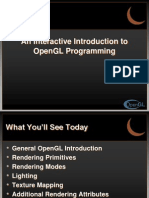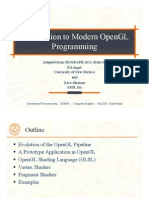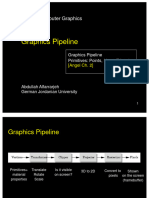0 ratings0% found this document useful (0 votes)
64 viewsProgramming in OpenGL Shaders
Programming in OpenGL Shaders
Uploaded by
Yoga Bayu Aji PranawaThree sentences:
The document discusses the structure and components of OpenGL programs, including initializing shaders, vertex arrays, and buffer objects to transfer data to the GPU for rendering. It also covers the basics of GLSL shader programming, including data types, qualifiers, and an example vertex and fragment shader. The goal is to build a complete first OpenGL program that uses shaders to render a simple colored triangle.
Copyright:
© All Rights Reserved
Available Formats
Download as PPTX, PDF, TXT or read online from Scribd
Programming in OpenGL Shaders
Programming in OpenGL Shaders
Uploaded by
Yoga Bayu Aji Pranawa0 ratings0% found this document useful (0 votes)
64 views42 pagesThree sentences:
The document discusses the structure and components of OpenGL programs, including initializing shaders, vertex arrays, and buffer objects to transfer data to the GPU for rendering. It also covers the basics of GLSL shader programming, including data types, qualifiers, and an example vertex and fragment shader. The goal is to build a complete first OpenGL program that uses shaders to render a simple colored triangle.
Original Description:
Pemrograman Grafika Komputer OpenGL menggunakan shaders
Copyright
© © All Rights Reserved
Available Formats
PPTX, PDF, TXT or read online from Scribd
Share this document
Did you find this document useful?
Is this content inappropriate?
Three sentences:
The document discusses the structure and components of OpenGL programs, including initializing shaders, vertex arrays, and buffer objects to transfer data to the GPU for rendering. It also covers the basics of GLSL shader programming, including data types, qualifiers, and an example vertex and fragment shader. The goal is to build a complete first OpenGL program that uses shaders to render a simple colored triangle.
Copyright:
© All Rights Reserved
Available Formats
Download as PPTX, PDF, TXT or read online from Scribd
Download as pptx, pdf, or txt
0 ratings0% found this document useful (0 votes)
64 views42 pagesProgramming in OpenGL Shaders
Programming in OpenGL Shaders
Uploaded by
Yoga Bayu Aji PranawaThree sentences:
The document discusses the structure and components of OpenGL programs, including initializing shaders, vertex arrays, and buffer objects to transfer data to the GPU for rendering. It also covers the basics of GLSL shader programming, including data types, qualifiers, and an example vertex and fragment shader. The goal is to build a complete first OpenGL program that uses shaders to render a simple colored triangle.
Copyright:
© All Rights Reserved
Available Formats
Download as PPTX, PDF, TXT or read online from Scribd
Download as pptx, pdf, or txt
You are on page 1of 42
WEEK 3: PROGRAMMING IN
OPENGL 2 COMPLETE PROGRAMS
Kuliah Grafika Komputer Jurusan Teknik Informatika ITS 2014
Objectives
Build a complete first program
Introduce shaders
Introduce a standard program structure
Simple viewing
Two-dimensional viewing as a special case of three-
dimensional viewing
Initialization steps and program structure
Program Structure
Most OpenGL programs have a similar structure that
consists of the following functions
main():
specifies the callback functions
opens one or more windows with the required properties
enters event loop (last executable statement)
init(): sets the state variables
Viewing
Attributes
initShader(): read, compile, and link shaders
callbacks
Display function
Input and window functions
simple.c revisited
main() function similar to last lecture
Mostly GLUT functions
init() will allow more flexible colors
initShader() will hides details of setting up
shaders for now
Key issue is that we must form a data array to send
to GPU and then render it
main.c
GLUT functions
glutInit initializes the GLUT system allows it to receive
command line arguments (always include this line)
gluInitDisplayMode requests properties for the window
(the rendering context)
RGBA color (default) or indexed colour (rare now)
Double buffering (usually) or Single buffering (redraw flickers)
Depth buffer (usually in 3D) stores pixel depths to find closest surfaces
[usually with glEnable(GL_DEPTH_TEST);]
Properties are bitwise ORed together with | (vertical bar)
glutInitWindowSize in pixels
glutInitWindowPosition from top-left corner of display
GLUT functions
glutCreateWindow create window with title Title
many functions need to be called prior to creating the window
similarly many other functions can only be called afterwards
glutDisplayFunc set display callback
glutKeyboardFunc set keyboard callback
glutReshapeFunc set window resize callback
glutTimerFunc set timer callback
glutIdleFunc set idle callback
glutMainLoop enter infinite event loop
never returns, but may exit
Immediate Mode Graphics
Geometry specified by vertices
Locations in space( 2 or 3 dimensional)
Points, lines, circles, polygons, curves, surfaces
Immediate mode
Each time a vertex is specified in application, its location
is sent to the GPU
Old style uses glVertex
Creates bottleneck between CPU and GPU
Removed from OpenGL 3.1
Retained Mode Graphics
Put all vertex and attribute data in array
Send array to GPU to be rendered immediately
Almost OK but problem is we would have to send
array over each time we need another render of it
Better to send array over and store on GPU for
multiple renderings
Display Callback
Once we get data to GPU, we can initiate the
rendering with a simple callback
void mydisplay()
{
glClear(GL_COLOR_BUFFER_BIT);
glDrawArrays(GL_TRIANGLES, 0, 3);
// glFlush(); // Single buffering
glutSwapBuffers(); // Double buffering
}
Arrays are buffer objects that contain vertex arrays
Vertex Arrays
Vertices can have many attributes
Position
Color
Texture Coordinates
Application data
A vertex array holds these data
Using types in vec.h
point2 vertices[3] = {point2(0.0, 0.0),
point2( 0.0, 1.0), point2(1.0, 1.0)};
Vertex Array Object
Bundles all vertex data (positions, colors, ..,)
Get name for buffer then bind
GLunit abuffer;
glGenVertexArrays(1, &abuffer);
glBindVertexArray(abuffer);
At this point we have a current vertex array but no
contents
Use of glBindVertexArray lets us switch between
VBOs
Buffer Object
Buffers objects allow us to transfer large amounts
of data to the GPU
Need to create, bind and identify data
GLuint buffer;
glGenBuffers(1, &buffer);
glBindBuffer(GL_ARRAY_BUFFER, buffer);
glBufferData(GL_ARRAY_BUFFER,
sizeof(points), points);
Data in current vertex array is sent to GPU
Initialization
Vertex array objects and buffer objects can be set up
on init()
Also set clear color and other OpenGL parameters
Also set up shaders as part of initialization
Read
Compile
Link
First lets consider a few other issues
Coordinate Systems
The units in points are determined by the application
and are called object, world, model or problem coordinates
Viewing specifications are also in object coordinates and it
is the size of the viewing volume that determines what will
appear in the image
Eventually, pixels will be produced in screen coordinates
(a.k.a. window coordinates)
OpenGL shaders also often use some internal
representations that usually are not visible to the
application, such as camera coordinates (generally prior to
perspective transformation)
OpenGL Camera
OpenGL places a camera at the origin in object
space pointing in the negative z direction
The default viewing volume
is a box centered at the
origin with a side of
length 2
Orthographic Viewing
z=0
z=0
In the default orthographic view, points are
projected forward along the z axis onto the
plane z=0
Viewports
Do not have use the entire window for the image:
glViewport(x,y,w,h)
Values in pixels (screen/window coordinates)
Transformations and Viewing
In OpenGL, projection is carried out by a projection matrix
(transformation)
Transformation functions are also used for changes in
coordinate systems
Pre 3.0 OpenGL had a set of transformation functions
which have been deprecated
Three choices in OpenGL 3+
Application code
GLSL functions
vec.h and mat.h
WEEK 3 PART 2: PROGRAMMING IN
OPENGL 2 SHADERS
Kuliah Grafika Komputer Jurusan Teknik Informatika ITS 2014
Objectives
Simple Shaders
Vertex shader
Fragment shaders
Programming shaders with GLSL
Finish first program
Vertex Shader Applications
Geometric transformations
Change relative location, rotation, scale of objects/camera
3D perspective transformation make far objects smaller
Moving vertices
Morphing
Wave motion & deformation due to physical forces
Particle effects for fire, smoke, rain, waterfalls,
Fractals
Lighting
Calculate shading color using light and surface properties
Can choose between less/more realistic models (unlike the fixed
pipeline)
Cartoon shaders, other special effects
Fragment Shader Applications
Per fragment lighting calculations
per vertex lighting per fragment lighting
Fragment Shader Applications
Texture mapping
smooth shading environment mapping bump mapping
Writing Shaders
First programmable shaders were programmed in an
assembly-like manner
OpenGL extensions added for vertex and fragment
shaders
Cg (C for graphics) C-like language for programming
shaders
Works with both OpenGL and DirectX
Interface to OpenGL complex
OpenGL Shading Language (GLSL)
GLSL
OpenGL Shading Language
Part of OpenGL 2.0 and up
High level C-like language
New data types
Matrices
Vectors
Samplers
As of OpenGL 3.1, application must provide shaders
Simple Vertex Shader
Execution Model
Simple Fragment Program
#version 150
out vec4 fragcolor;
void main(void) {
fragcolor = vec4(1.0, 0.0, 0.0, 1.0);
}
Execution Model
Data Types
C types: int, float, bool
Vectors:
float vec2, vec3, vec4
Also int (ivec) and boolean (bvec)
Matrices: mat2, mat3, mat4
Stored by columns
Standard referencing m[row][column]
C++ style constructors
vec3 a =vec3(1.0, 2.0, 3.0)
vec2 b = vec2(a)
Pointers
There are no pointers in GLSL
We can use C structs which can be copied back
from functions
Because matrices and vectors are basic types they
can be passed into and output from GLSL functions,
e.g.
mat3 func(mat3 a)
Qualifiers
GLSL has many of the same qualifiers such as const
as C/C++
Need others due to the nature of the execution
model
Variables can change
Once per primitive
Once per vertex
Once per fragment
At any time in the application
Vertex attributes are interpolated by the rasterizer
into fragment attributes
Attribute Qualifier
Attribute-qualified variables can change at most
once per vertex
There are a few built in variables such as
gl_Position but most have been deprecated
User defined (in application program)
Use in qualifier to get to shader
in float temperature
in vec3 velocity
Uniform Qualified
Variables that are constant for an entire primitive
Can be changed in application and sent to shaders
Cannot be changed in shader
Used to pass information to shader such as the
bounding box of a primitive
Varying Qualified
Variables that are passed from vertex shader to
fragment shader
Automatically interpolated by the rasterizer
Old style used the varying qualifier
varying vec4 color;
Now use out in vertex shader and in in the fragment
shader
out vec4 color;
Example: Vertex Shader
#version 150
const vec4 red = vec4(1.0, 0.0, 0.0, 1.0);
in vec4 vPosition;
out vec4 color_out;
void main(void)
{
gl_Position = vPosition;
color_out = red;
}
Required Fragment Shader
#version 150
in vec4 color_out;
out vec4 fragcolor;
void main(void) {
fragcolor = color_out;
}
// in pre-OpenGL 3.2 versions use built-in:
// gl_FragColor = color_out;
Passing values
call by value-return
Variables are copied in
Returned values are copied back
Three possibilities
in
out
inout (deprecated)
Operators and Functions
Standard C functions
Trigonometric
Arithmetic
Normalize, reflect, length
Overloading of vector and matrix types
mat4 a;
vec4 b, c, d;
c = b*a; // a column vector stored as a 1d array
d = a*b; // a row vector stored as a 1d array
Swizzling and Selection
Can refer to array elements by element using [] or
selection (.) operator with
x, y, z, w
r, g, b, a
s, t, p, q
a[2], a.b, a.z, a.p are the same
Swizzling operator lets us manipulate components
vec4 a;
a.yz = vec2(1.0, 2.0);
Next week: Programming in OpenGL
4-5: Polygons & Attributes, More GLSL
You might also like
- IT Governance: Group 4: James Fort Stephanie Joyner Jeff SeremakDocument17 pagesIT Governance: Group 4: James Fort Stephanie Joyner Jeff SeremakYoga Bayu Aji PranawaNo ratings yet
- CAD by Sandeep Jyani Sir WifistudyDocument195 pagesCAD by Sandeep Jyani Sir WifistudySumit SagarNo ratings yet
- Build Your Torcs Track in 20 MinutesDocument67 pagesBuild Your Torcs Track in 20 Minutesapi-3715720No ratings yet
- Epiq 5WDocument36 pagesEpiq 5WLucas MuñozNo ratings yet
- Shader FundamentalsDocument154 pagesShader FundamentalsAlaa ZainNo ratings yet
- 2D Drawing & OpenglDocument68 pages2D Drawing & OpenglEng Peter TabboNo ratings yet
- Introduction To Modern Opengl Programming: Ed Angel University of New Mexico Dave Shreiner Arm, IncDocument109 pagesIntroduction To Modern Opengl Programming: Ed Angel University of New Mexico Dave Shreiner Arm, IncSaitej VarriNo ratings yet
- An Interactive Introduction To Opengl ProgrammingDocument121 pagesAn Interactive Introduction To Opengl Programmingrahul.yerrawar100% (1)
- Evolution of Graphics API: Sujal Bista CMSC 828VDocument26 pagesEvolution of Graphics API: Sujal Bista CMSC 828VJohn IveNo ratings yet
- Open GLDocument161 pagesOpen GLRavi ParkheNo ratings yet
- Comp 336 CG Manual OpenglDocument62 pagesComp 336 CG Manual OpenglHazimNo ratings yet
- CIT 2211 - Lecture 3 - Graphics SoftwareDocument50 pagesCIT 2211 - Lecture 3 - Graphics Softwarerisksentinel.objNo ratings yet
- 21CS63 PPT 3Document37 pages21CS63 PPT 3chandansNo ratings yet
- Graphic MidtermDocument5 pagesGraphic MidtermKhaijin LimNo ratings yet
- Graphics S/W: - 1.special Purpose Packages. - 2. General Programming PackagesDocument27 pagesGraphics S/W: - 1.special Purpose Packages. - 2. General Programming PackagesToby ThomasNo ratings yet
- CH 678Document46 pagesCH 678Olana TeressaNo ratings yet
- Computer Graphics (CG CHAP 3)Document15 pagesComputer Graphics (CG CHAP 3)Vuggam Venkatesh0% (1)
- OPENGL - IntroDocument21 pagesOPENGL - IntroNivedita kNo ratings yet
- Unit 2: Graphics Programming The Opengl: by Shubha Raj K.BDocument146 pagesUnit 2: Graphics Programming The Opengl: by Shubha Raj K.BRishabh BansalNo ratings yet
- Lecture9 Interactive 3D GraphicsDocument36 pagesLecture9 Interactive 3D GraphicsMichael RussoNo ratings yet
- CG ManualDocument39 pagesCG Manualsanthosh reddyNo ratings yet
- 02 Shading LanguageDocument20 pages02 Shading LanguageAchmad TaufiqNo ratings yet
- Computer Graphics Lab ManualDocument54 pagesComputer Graphics Lab Manualjohnhaile23No ratings yet
- Unit 1 PDFDocument109 pagesUnit 1 PDFrajath bhatNo ratings yet
- Open GLDocument106 pagesOpen GLNishanthoraNo ratings yet
- Chapter 3 & 4: Rendering Process With OpenglDocument79 pagesChapter 3 & 4: Rendering Process With OpenglEmanNo ratings yet
- Chapter 6 Introduction To OpenGLDocument10 pagesChapter 6 Introduction To OpenGLdenis kipkiruiNo ratings yet
- Introduction To OpenGLDocument34 pagesIntroduction To OpenGLDiEpNo ratings yet
- Processing 15shadersDocument41 pagesProcessing 15shadersWeliton De Bortoli100% (1)
- Catch ReportDocument25 pagesCatch Reportkaluukaluu412No ratings yet
- PipelineDocument26 pagesPipelinejude joboriNo ratings yet
- Computer Graphics Lecture 4Document55 pagesComputer Graphics Lecture 4Crystal DzebuNo ratings yet
- Slides Theory1 Shaders PipelineDocument22 pagesSlides Theory1 Shaders Pipelinealan88wNo ratings yet
- Graphics - Lecture 1 Part 2Document29 pagesGraphics - Lecture 1 Part 2Zohaib KiyaniNo ratings yet
- Unit I: Raphics Primitives and Scan Conversion AlgorithmDocument42 pagesUnit I: Raphics Primitives and Scan Conversion AlgorithmShishir AgrahariNo ratings yet
- 02 - PrimitivesDocument87 pages02 - PrimitivesTeshome MulugetaNo ratings yet
- OpenglDocument17 pagesOpenglLavanya UmapathyNo ratings yet
- CG Laboratory 2Document8 pagesCG Laboratory 2Florentina Lăculiceanu SirbulescuNo ratings yet
- A Brief Introduction To 3dDocument84 pagesA Brief Introduction To 3dNarwhalNo ratings yet
- Open GL ES 2.0Document43 pagesOpen GL ES 2.0brunoadamNo ratings yet
- CH4-7 GRAPH LectureDocument36 pagesCH4-7 GRAPH LecturepyramidmistreNo ratings yet
- An Overview of Opengl: I Iti PrimitivesDocument8 pagesAn Overview of Opengl: I Iti PrimitivesLeeNo ratings yet
- CSE4204 - Computer Graphics Lab - 1Document17 pagesCSE4204 - Computer Graphics Lab - 1আনিকা সিদ্দিকাNo ratings yet
- Opengl BasicsDocument46 pagesOpengl Basicssadhanamca1No ratings yet
- Assignment 1Document16 pagesAssignment 1Muhammad AhmadNo ratings yet
- Chapter 3Document33 pagesChapter 3SabonaNo ratings yet
- CG Lab ManualDocument52 pagesCG Lab ManualSrisaila NathNo ratings yet
- Computer Graphics (Unit2)Document107 pagesComputer Graphics (Unit2)JACKNo ratings yet
- Introduction To OpenglDocument40 pagesIntroduction To OpenglSorin SecanNo ratings yet
- AeroCrash ReportDocument26 pagesAeroCrash ReportKrishna Yadav0% (1)
- Introduction To OpenGLDocument27 pagesIntroduction To OpenGLgouthamnaikNo ratings yet
- A Survey Paper On OpenGL ESDocument4 pagesA Survey Paper On OpenGL ESEditor IJRITCCNo ratings yet
- CgfullDocument58 pagesCgfullshaquibk449No ratings yet
- Cse581 02 Opengl IntroDocument47 pagesCse581 02 Opengl IntroJaspreet SinghNo ratings yet
- Mini Project On Bezier Curves Using Visual Studio.Document22 pagesMini Project On Bezier Curves Using Visual Studio.Shashank100% (5)
- Image Processing For Displacement Filters, Including SwirlDocument20 pagesImage Processing For Displacement Filters, Including SwirlNhóc Bướng BỉnhNo ratings yet
- GDC2003 OGL ARBVertexProgram PDFDocument58 pagesGDC2003 OGL ARBVertexProgram PDFBalqis YafisNo ratings yet
- Car ModelDocument36 pagesCar Modelshashank776052No ratings yet
- Cse VI Computer Graphics and Visualization 10cs65 SolutionDocument55 pagesCse VI Computer Graphics and Visualization 10cs65 SolutionAnusha AnushaNo ratings yet
- CGV 18cs67 Lab ManualDocument45 pagesCGV 18cs67 Lab ManualNagamani DNo ratings yet
- Assignment 4 Volume Rendering With GLSL ShadersDocument6 pagesAssignment 4 Volume Rendering With GLSL ShadersDan ElliottNo ratings yet
- Open GL (Ebook) Shader Programming - CGFX Opengl 2.0 PDFDocument35 pagesOpen GL (Ebook) Shader Programming - CGFX Opengl 2.0 PDFluissustaitaNo ratings yet
- Programming Your GPU with OpenMP: Performance Portability for GPUsFrom EverandProgramming Your GPU with OpenMP: Performance Portability for GPUsNo ratings yet
- Shader: Exploring Visual Realms with Shader: A Journey into Computer VisionFrom EverandShader: Exploring Visual Realms with Shader: A Journey into Computer VisionNo ratings yet
- Registration-Set-Up GuideDocument6 pagesRegistration-Set-Up GuideYoga Bayu Aji PranawaNo ratings yet
- Telkom Wellbeing 147474Document1 pageTelkom Wellbeing 147474Yoga Bayu Aji PranawaNo ratings yet
- Set Up and Configure A Cloud Environment in Google Cloud: Challenge Lab - QwiklabsDocument1 pageSet Up and Configure A Cloud Environment in Google Cloud: Challenge Lab - QwiklabsYoga Bayu Aji PranawaNo ratings yet
- Appendix - Ii: Time TableDocument15 pagesAppendix - Ii: Time TableChakradhar DNo ratings yet
- BIMPRODocument12 pagesBIMPROehsan.mehrfardNo ratings yet
- BIM À Quoi SertDocument42 pagesBIM À Quoi SertAbdelhadi AIT-MANSSOURNo ratings yet
- MM SoftwareDocument12 pagesMM SoftwareRais RizalNo ratings yet
- 3D Viewing and Visible Surface Detection: Module - 4Document50 pages3D Viewing and Visible Surface Detection: Module - 4Shain SethiNo ratings yet
- Getting Started With PDMSDocument114 pagesGetting Started With PDMSAbam JoshuaNo ratings yet
- Faro Focus 3d Laser Scanner BrochureDocument4 pagesFaro Focus 3d Laser Scanner BrochureHrishikesh GarudNo ratings yet
- Eg Syllabus 2023Document3 pagesEg Syllabus 2023Premchand V. P.No ratings yet
- Sweet Home 3D - User's GuideDocument14 pagesSweet Home 3D - User's GuidevedavyasNo ratings yet
- Explanations of Various Types of Video Editing ToolsDocument5 pagesExplanations of Various Types of Video Editing Toolsnilu royNo ratings yet
- Revit Platform Api Changes and Additions 2024 01Document31 pagesRevit Platform Api Changes and Additions 2024 01Wallas EstevamNo ratings yet
- Gujarat Technological University Government Engineering College GodhraDocument32 pagesGujarat Technological University Government Engineering College GodhraVishvajit BariaNo ratings yet
- 3218 Porsche Carrera GT Tutorial by Nimish RajwadeDocument6 pages3218 Porsche Carrera GT Tutorial by Nimish RajwadeArturo PisanoNo ratings yet
- Basic Guide (001-150) PDFDocument150 pagesBasic Guide (001-150) PDFBryanNicasioNo ratings yet
- Brinkgreve Et Al 2023 - Automated CPT Interpretation and Modelling in A BIM-Digital Twin EnvironmentDocument7 pagesBrinkgreve Et Al 2023 - Automated CPT Interpretation and Modelling in A BIM-Digital Twin EnvironmentBOOBOONo ratings yet
- Grade 10 (Arts) - AnimationDocument44 pagesGrade 10 (Arts) - AnimationCharlyn SolomonNo ratings yet
- 3D - Quick Start - OptitexHelpEnDocument26 pages3D - Quick Start - OptitexHelpEnpanzon_villaNo ratings yet
- Infrawork Road - Design - WorkflowDocument38 pagesInfrawork Road - Design - WorkflowMk& Mp MTS Tama JagakarsaNo ratings yet
- MmlabDocument39 pagesMmlabrushi kolliNo ratings yet
- Autodesk Advance Steel 2025Document1 pageAutodesk Advance Steel 2025Mendrika RAZAFINDRABENo ratings yet
- Scientific Visualisation 7Document52 pagesScientific Visualisation 7JZ millerNo ratings yet
- Creating A Parametric Muqarnas Utilizing Algorithmic SoftwareDocument7 pagesCreating A Parametric Muqarnas Utilizing Algorithmic Softwarenakta samipoorNo ratings yet
- Sim Wise BrochureDocument8 pagesSim Wise Brochureep_frenzNo ratings yet
- DLL - Mapeh 6 - Q4 - W4Document4 pagesDLL - Mapeh 6 - Q4 - W4Quin Lyster AbreaNo ratings yet
- Mathan Kumar Graphic DesignerDocument2 pagesMathan Kumar Graphic DesignerFajas MohammedNo ratings yet
- Pix 4 DmapperDocument2 pagesPix 4 DmapperjovanNo ratings yet
- Hwdesktop13.0.110 ReleaseNotesDocument162 pagesHwdesktop13.0.110 ReleaseNotesogchmNo ratings yet





























































































